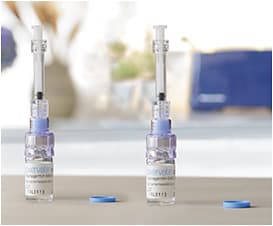What’s new for your patients and practice

1. Alcon’s AcrySof IQ PanOptix Trifocal Intraocular Lens
This lens is designed for visual clarity at near, far, and intermediate distances, using diffractive light-splitting technology. Specifically, the lens bends light rays to allow them to focus on the retina, providing improved distance vision. It is available in spherical and toric designs.
“Many physicians consider the lens to be an improvement from its predecessors, particularly from certain bifocal designs,” says Marguerite McDonald, MD, FACS, clinical professor of ophthalmology, NYU Langone Medical Center, New York.
The AcrySof IQ PanOptix Trifocal lens is implanted in patients who are at least 22 years old. It comes in both a spherical version and a toric version. It is a single-piece IOL with a diffractive aspheric optic with 2.17-D intermediate and +3.25-D near add power on the IOL plane (representing approximately +1.65 D and +2.35 D, respectively, on the corneal plane). It can correct up to 3.75 D of corneal astigmatism.

2. Sun Ophthalmic’s Cequa (cyclosporine 0.09%) Dry Eye Disease Treatment
This treatment is a calcineurin inhibitor immunosuppressant indicated to increase tear production in dry eye disease patients. It is comprised of cyclosporine ophthalmic solution 0.09%.
“Cequa gives corneal specialists another option for the treatment of dry eye,” says Kendall E. Donaldson, MD, MS, a professor of clinical ophthalmology and medical director of the Bascom Palmer Eye Institute in Plantation, FL. “Through the years, we have been very limited regarding treatment options for dry eye. The promising tolerability profile and rapid onset of action of Cequa make it a wonderful option for some patients.”

3. Ocular Therapeutix’s Dextenza
This device is inserted into the punctum after surgery to treat pain and inflammation. As a dexamethasone ophthalmic intracanalicular insert, Dextenza is used instead of topical corticosteroid eyedrops during the early postoperative period. It delivers 30 days of sustained release of dexamethasone to the eye’s surface.
Dexamethasone has long been used in ophthalmology, Dr. McDonald says. Dextenza lessens the treatment burden for patients; it is preservative free, which is kinder to the ocular surface, and it does not require removal.
4. Dompé‘s Oxervate
Oxervate is the first FDA-approved drug for treating neurotrophic keratitis, which can lead to corneal melting, scarring, and vision loss. The ophthalmic solution contains nerve growth factor, which allows corneal nerves to regenerate in the presence of neurotrophic keratitis. This regeneration can lead to corneal healing and the re-establishment of a stable trophic environment on the ocular surface.
Ken Beckman, MD, FACS, director, corneal service, Comprehensive EyeCare of Central Ohio, Westerville, OH, says the drug is beneficial because it treats the underlying cause of the condition.

Patients should use the eyedrops for 8 weeks, 6 times per day. In clinical trials, up to 72% of patients noted complete epithelial healing (no staining) after 8 weeks of treatment. Oxervate was well tolerated in clinical trials. Eighty percent of those healed remained healed at 1 year after an 8-week course of treatment.

5. RxSight’s Light Adjustable Lens
RxSight’s light adjustable lens is an intraocular implant for patients undergoing cataract surgery or a refractive lens exchange, and it allows for minor refractive adjustments postoperatively, so that patients can obtain their very best uncorrected vision. Three to 4 weeks after surgery, the patient is examined, and if desired, the physician can adjust the lens power with a light-delivery technology.
“The lens is very useful for patients when achieving excellent uncorrected vision is more challenging, such as in patients with a history of RK or LASIK,” says William Trattler, MD, director of cornea, Center for Excellence in Eye Care in Miami, FL. Residual myopia, hyperopia, and astigmatism can be corrected.
The FDA approved the initial version of the light adjustable lens and light delivery device in 2017, but they were not commercialized. Instead, RxSight conducted additional FDA clinical trials to further enhance the lens’ and light delivery device’s capabilities. The latest generation of the light adjustable lens received final FDA approval in 2019 and was launched commercially last summer, says Dr. Trattler, whose practice is among the first 10 U.S. sites using RxSight’s system. CP








